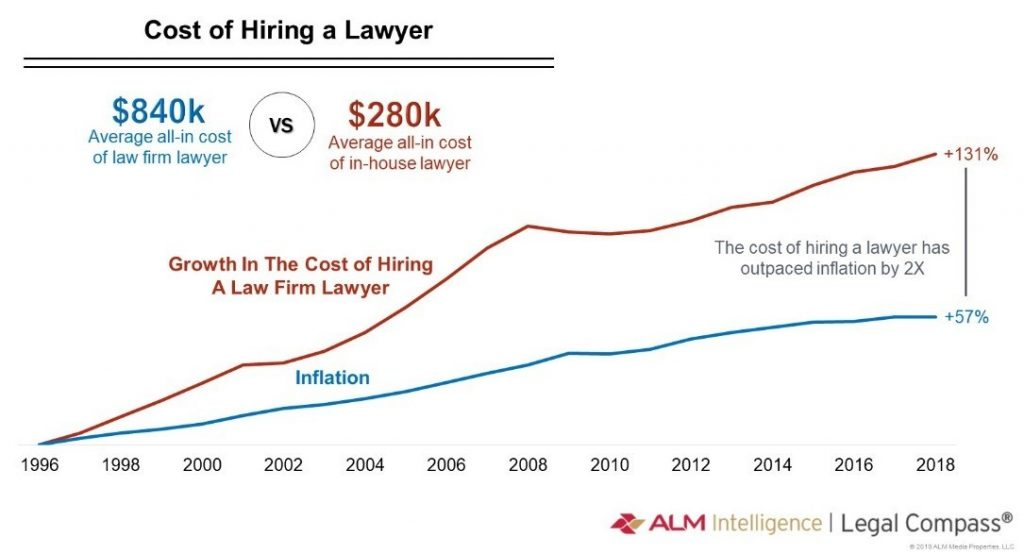
Despite legal operations being a relatively established function (only 2% of organizations are not focusing on it), 44% of organizations assign legal ops responsibilities to a corporate lawyer rather than a dedicated person. However, the broader trend is toward creating dedicated legal operations positions and building teams. So how do you prepare and train your existing team for legal operations success?
WHAT IS LEGAL OPERATIONS?
“Legal operations” has been around longer than you might realize; for example, the Corporate Legal Operations Institute (CLOC) formed in 2010. Many legal operations functions have been around for years, just without the name attached. The focus is usually on driving efficiencies, controlling spend, monitoring external counsel fees, and deriving KPIs.
Generally, legal operations encompasses all the functions of the legal department that are not the law itself. CLOC breaks these areas into 12 competencies at three maturity levels; you can find this resource on their website. The typical skills and responsibilities of legal operations are to:
- Define and drive initiatives to improve efficiency and process workflows.
- Manage outside counsel guidelines, legal spend (visibility, control, and reduction), and department budget.
- Optimize law firm performance for maximum value for money.
- Implement, measure, and analyze metrics that inform decision-making, turning them into actions that deliver improvements.
- Implement technology to achieve departmental and business goals.
- Work cross-functionally to demonstrate the legal department’s value within the organization.
- Understand and monitor the risks, risk appetite, and risk profile of the legal department within the organization’s framework.
So why the recent focus on legal operations? As businesses grow in scope and complexity, the volume and breadth of legal expertise required increases, and costs also go up. General Counsel are under more pressure than ever to justify their legal costs, improve the efficiency of their department, and collaborate with the broader business.
Legal operations will bring the legal department closer to the business and thus to the other specialist departments, resulting in Legal playing a different, more critical role in the company. With this demand to make the legal department act more “like a business” comes a need for cost control and process improvement. The problem with this for a traditional legal team is two-fold. First, the legal department’s priority will always be to advise on legal matters. Operations will take a back seat during busy periods or with an insufficiently staffed team. Second, achieving operational and business goals requires skills that are not necessarily part of a lawyer’s standard repertoire.
DEVELOPING LEGAL OPERATIONS SKILLS IN THE CORPORATE LEGAL TEAM
Whether your legal department has a dedicated legal operations resource, a whole team, or legal counsel doing legal operations as part of their “day job,” now is a vital time to future-proof your entire legal team and get them thinking beyond the practice of law. In-house lawyers have many skills that will enable them to succeed in legal operations, including law firm management, company knowledge, and a deep understanding of the legal department’s day-to-day operations and challenges. However, more is needed, and lawyers’ skills gaps tend to be in technology and software, change management, budgeting, and analytics.
Finding people with all these skills will be rare; whether your legal operations head should be a lawyer or non-lawyer is a matter for debate, but most agree that the end goal should be a diverse team of lawyers, non-lawyers, and specialist experts supported by the whole team having at least a basic knowledge of all the functions of legal operations.
Some of the ways to build these additional skills into your corporate legal team include:
JOB SHARING/SHADOWING
Consider placing lawyers with finance, sales, marketing, operations, product management, and data analysis – any area of the business that will broaden their skillset in a way that addresses one of the functions of legal operations. The challenge will be finding colleagues from these other departments qualified to do a genuine “job swap” into Legal. Shadowing is a desirable alternative in these scenarios. Also, try to upskill the non-lawyers in the legal operations team. Allowing them to shadow lawyers will enable them to better understand the different roles, responsibilities, and challenges facing the lawyers and hopefully build stronger working relationships within the function.
LEADING PROJECTS
It’s more than likely that your team members will have already been involved in large projects such as a merger or acquisition, but only from the legal perspective. If they lead the whole project, they will get exposed to other areas of the business and their impact on the overall recommendation and outcome. It doesn’t even have to be such a big project. An internal re-brand, product launch, or HR initiative will all work. Involvement in a software roll-out would be beneficial. Managing projects that involve stakeholders from multiple departments to deadlines and budget is a key part of legal operations, so leading any cross-functional project will build these skills.
TRAINING COURSES, CONFERENCES, NEWSLETTERS
The most obvious way to build the skills you need in your team is through training courses, but conferences can also impart knowledge and inspiration. Training doesn’t have to be an external cost as many of the skills will exist in the company already, and colleagues from other departments can help train. For example, lawyers should gain insights into data analysis, cloud, cyber security, AI, and commercials. Likewise, the business background professionals about the practice of law and the legal market so that they can provide the most value.
IMPLEMENT AND USE TECHNOLOGY
In today’s digitalized world, goals such as transparency, efficiency gains, and data analysis come through the combination of skilled personnel and software. The legal operations discipline is no exception to this; just look at the world’s leading legal operations teams. Each one relies on tailor-made legal operations tools in their daily work.
For this reason, empower your team to think about what slows them down at work daily and investigate if technology could solve these challenges. Encourage them to research and recommend software tools to help them and the wider team and lead the roll-out project.
REGULAR PRESENTATIONS AND OPEN Q&A ABOUT COMPANY REVENUE, PROFITS AND GOALS
If your company does regular “town halls” where they present financial updates and mission statements, encourage your team to attend these or start doing them just for your Legal team if they don’t exist on a company level. Get your team interested and educated in the organization’s financial health and how legal can contribute. A modern legal team must be fluent in financial terminology and confident with budgeting and reporting.
Request a demo of BusyLamp eBilling.Space today.












